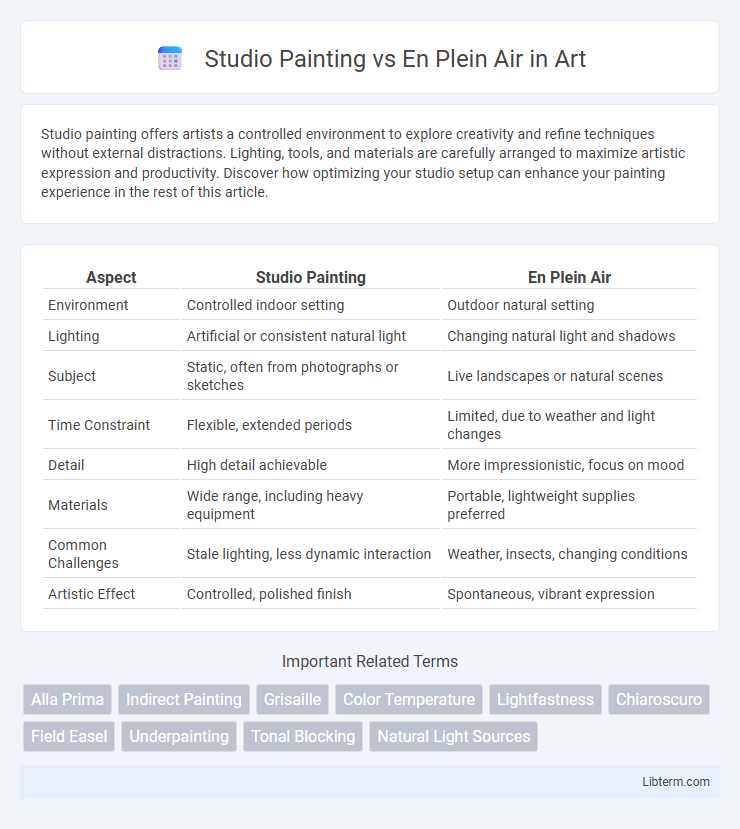Studio painting offers artists a controlled environment to explore creativity and refine techniques without external distractions. Lighting, tools, and materials are carefully arranged to maximize artistic expression and productivity. Discover how optimizing your studio setup can enhance your painting experience in the rest of this article.
Table of Comparison
| Aspect | Studio Painting | En Plein Air |
|---|---|---|
| Environment | Controlled indoor setting | Outdoor natural setting |
| Lighting | Artificial or consistent natural light | Changing natural light and shadows |
| Subject | Static, often from photographs or sketches | Live landscapes or natural scenes |
| Time Constraint | Flexible, extended periods | Limited, due to weather and light changes |
| Detail | High detail achievable | More impressionistic, focus on mood |
| Materials | Wide range, including heavy equipment | Portable, lightweight supplies preferred |
| Common Challenges | Stale lighting, less dynamic interaction | Weather, insects, changing conditions |
| Artistic Effect | Controlled, polished finish | Spontaneous, vibrant expression |
Introduction to Studio Painting and En Plein Air
Studio painting offers a controlled environment where artists can manipulate lighting, composition, and materials to achieve precise details and refined techniques. En plein air painting emphasizes capturing natural light, atmosphere, and the essence of the landscape by working outdoors directly within the scene. Both methods provide unique challenges and creative opportunities, influencing an artist's approach to color, mood, and spontaneity.
Historical Background of Both Techniques
Studio painting emerged during the Renaissance as artists prioritized controlled lighting and composition within indoor settings, allowing detailed preparation and refinement. En plein air painting gained momentum in the 19th century with the Impressionist movement, emphasizing direct observation of natural light and atmosphere outdoors. This shift marked a significant evolution in artistic practice, contrasting the meticulous studio environment with spontaneous outdoor creativity.
Key Differences in Artistic Process
Studio painting allows artists controlled lighting, consistent conditions, and the ability to refine details at their own pace, fostering meticulous composition and layering techniques. En plein air painting captures natural light and dynamic environmental elements in real-time, demanding swift execution and adaptability to shifting weather and lighting. The key difference lies in studio painting's emphasis on detail and control versus en plein air's focus on spontaneity and direct interaction with nature.
Tools and Materials: Indoors vs. Outdoors
Studio painting requires a wider variety of controlled tools such as easels, palettes, and multiple brushes, along with oil, acrylic, or watercolor paints optimized for indoor use. En plein air painting demands portable and lightweight materials including compact easels, travel palettes, and quick-drying paint mediums like gouache or watercolors suitable for changing weather conditions. Outdoor setups emphasize durability and ease of transport, often incorporating solvent-free paints and minimal equipment tailored for natural light and environment.
Influence of Environment on Creativity
Studio painting offers controlled lighting and consistent conditions, allowing artists to meticulously develop details and refine techniques. En plein air painting immerses artists in dynamic natural settings, directly capturing atmospheric changes, light variations, and authentic color palettes. The immediate sensory experience outdoors often sparks spontaneous creativity and unique interpretations influenced by shifting environmental elements.
Advantages of Studio Painting
Studio painting offers controlled lighting and weather conditions, allowing artists to focus on intricate details without external distractions. It provides access to a wide range of materials and references, facilitating experimentation with techniques and color palettes. Consistent environment in the studio supports longer working sessions, enhancing precision and refinement in artwork.
Advantages of En Plein Air Painting
En plein air painting offers the advantage of capturing natural light and atmospheric conditions with immediate authenticity, enhancing color accuracy and dynamic shadows. This approach facilitates direct observation of changing environmental elements, resulting in spontaneous and vibrant compositions that studio settings often lack. Immersing artists in outdoor surroundings also stimulates sensory experiences and emotional connections, enriching creative expression and depth in the artwork.
Common Challenges in Each Approach
Studio painting often faces challenges related to artificial lighting and a lack of natural atmosphere, which can hinder accurate color representation and dynamic mood capture. En plein air painting requires artists to contend with rapidly changing weather conditions, shifting light, and environmental distractions that can interrupt the creative process. Both approaches demand strong observational skills and adaptability to effectively translate visual impressions into compelling artworks.
Notable Artists and Famous Works
Notable artists like Claude Monet and Pierre-Auguste Renoir excelled in en plein air painting, capturing natural light and landscapes with spontaneity, as seen in Monet's "Impression, Sunrise" and Renoir's "Luncheon of the Boating Party." Studio painters such as Pablo Picasso and Henri Matisse focused on controlled environments, producing masterpieces like Picasso's "Les Demoiselles d'Avignon" and Matisse's "The Dance," emphasizing composition and color theory. En plein air emphasizes direct observation and light effects, whereas studio painting allows for complex layering and imaginative freedom.
Choosing the Right Approach for Your Style
Studio painting offers controlled lighting and environment, allowing artists to perfect details and experiment with complex compositions over extended periods. En plein air painting captures the immediacy of natural light and vibrant outdoor scenes, ideal for artists seeking spontaneity and dynamic color shifts. Selecting the right approach depends on your style preference--meticulous refinement suits studio settings, while expressive, impressionistic works thrive en plein air.
Studio Painting Infographic

 libterm.com
libterm.com